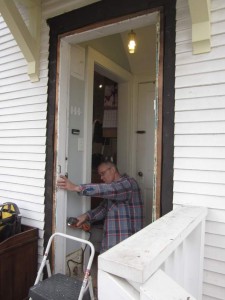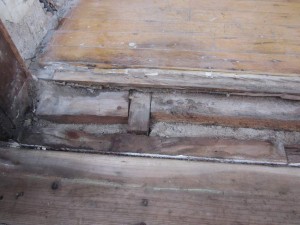Marge! That’s the Rhinestone Nights fashion gun! I need it to rhinestone up my old clothing.
– Homer Simpson
Yesterday, we replaced an exterior door. Today, I am licking my wounds (not literally, of course, because I’m too dang sore to move, much less lick anything). “Replacing a door” is, of course, code for “punching a huge hole in the house that you must fill before nightfall.”
Opening a wall provokes anxiety because of the high chance of a major “d’oh!” moment. In this case, we were lucky.
That last floor board inside the threshold is disintegrating. On this occasion, the problem was quickly remedied because we have a stash of matching floorboards that we pulled out of the bathroom a couple of years ago. In the throes of a project, nothing beats having the exact thing you need, especially for an unscheduled task.
I love architectural salvage shops and reuse centers—they are my idea of a Saturday afternoon well-spent. At least the afternoon: finding vintage house parts is no quick run to Home Depot. The Kev and I have quite a few items in storage because we just might need (or want) them later. Having a spare matching doorknob when you want it is waaay better than eventually finding one that’s close for $15. There were lots of bits and pieces secreted around the house when we arrived, and we save items from our own renovations, reusing everything from sash pulls to a buffet-sized cabinet.
Having said that, I’m not sure why we have most of the original electrical boxes we replaced over the years. Or the box of antique sandpaper. We did scrap the spare radiator pipes after I tripped over them in dramatic fashion, but not before we moved them around the house and garage for some years.
If I had to boil it down? Save your own architectural antiques, and let go of non-compliant infrastructure. Or try to let go. Some of that stuff is pretty cool.
DIY Tip: When insulating around your new door frame, look for expanding foam that’s not all that expansive. Some of the products for filling cracks are hard to control in a small space. Minimally expanding foam sprays grow less than 20% or so, which is just the sort of expansion you need to tuck your door in neatly.




